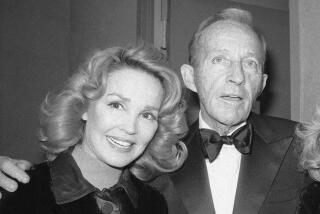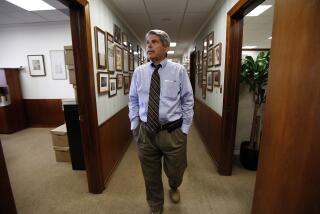Bing Crosby
- Share via
FEW pop-culture figures resonated with American troops in World War II the way Bing Crosby did. He was a tireless figure on USO tours in Europe and when his rich, dignified baritone gave them “White Christmas” or “I’ll Be Home for Christmas,” the weary soldiers heard the sound of the home front and the promise of peacetime. So in 1944, when Crosby hit No. 1 with a jaunty song called “San Fernando Valley,” it was no surprise that GIs heard it as a call to build their postwar lives in a new Eden out west.
Oh, I’m packing my grip
For the record:
12:00 a.m. May 6, 2007 For The Record
Los Angeles Times Sunday May 06, 2007 Home Edition Main News Part A Page 2 National Desk 1 inches; 64 words Type of Material: Correction
SoCal Songbook: The column in today’s Arts & Music section refers to a song written by Gordon Jenkins as “That’s All I Ask.” The title is “This Is All I Ask.” The column also suggests Jenkins was the songwriter of “When I Fall in Love,” “My Foolish Heart” and “September of My Years.” He arranged recordings of those songs but did not write them.
For The Record
Los Angeles Times Sunday May 13, 2007 Home Edition Sunday Calendar Part E Page 2 Calendar Desk 1 inches; 60 words Type of Material: Correction
Gordon Jenkins: The SoCal Songbook column last Sunday misidentified a song written by Gordon Jenkins as “That’s All I Ask.” The title is “This Is All I Ask.” The story also called Jenkins the songwriter of “When I Fall in Love,” “My Foolish Heart” and “September of My Years.” He arranged recordings of those songs but did not write them.
And I’m leaving today,
‘Cause I’m taking a trip
California way
I’m gonna settle down and never more roam
And make the San Fernando Valley my home.
It seemed as if the chamber of commerce had ordered up a new civic anthem to sell wood-frame houses in “America’s suburb.” That was hardly the case. The ditty was written by Gordon Jenkins, a songwriter whose work included “That’s All I Ask,” “When I Fall in Love,” “My Foolish Heart,” “September of My Years” and many others. On “San Fernando Valley,” he was writing a quick-money theme for a 1943 Roy Rogers western of the same title. The movie was filmed in the Valley, and while it faded quickly from memory, its song became a hit -- which shocked and somewhat embarrassed Jenkins.
“I heard him say on an old radio show that he hated the song,” said Bruce Jenkins, a journalist and the author of “Goodbye,” a biography of his father. “He thought it was complete junk, but something that might pay a few bills. Then it turned into a big hit, and as he said later, ‘You feel differently about a song once the checks start rolling in.’ ”
The songwriter, a Missouri native, arrived in Los Angeles in 1938 with a plan to score Hollywood films. That opportunity soured him though, and he moved to Sherman Oaks to avoid “the song-plugging and politics of Hollywood.” The place was bucolic and quaint, which inspired his reference to “hitting the trail to cow country” in the song.
Still, the language that probably resonated with men fresh from combat was more about redemption than landscape.
I’ll forget my sins,
I’ll be makin’ new friends,
Where the West begins
And the sunset ends
‘Cause I’ve decided where yours truly should be
and it’s the San Fernando Valley for me.
Gordon Jenkins may have cashed the checks, but he never quite understood the allure of his toss-off No. 1 hit. His son said the house was always full of music, but that song never once was played.
“I guarantee you that,” the younger Jenkins says. “He wanted to keep making money off of it, but he also wished there was a way to do it without anybody hearing the thing. It bugged him when it came on the radio.”
Maybe he didn’t want to hear all those newcomers to the Valley whistling it on the sidewalks; Jenkins packed his own bags and moved to Malibu in 1946.
-- Geoff Boucher
More to Read
Sign up for The Wild
We’ll help you find the best places to hike, bike and run, as well as the perfect silent spots for meditation and yoga.
You may occasionally receive promotional content from the Los Angeles Times.






